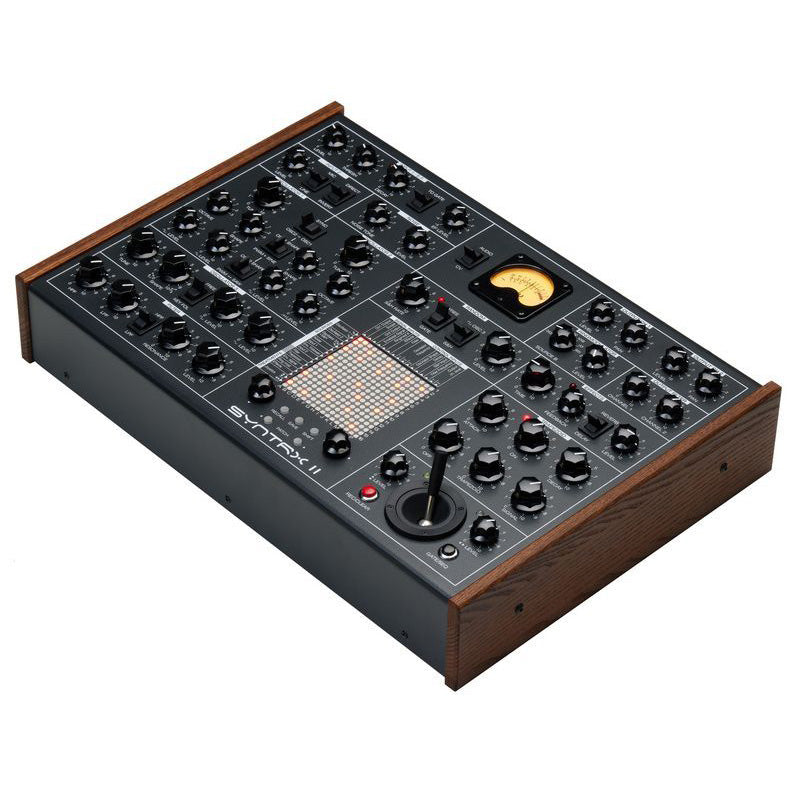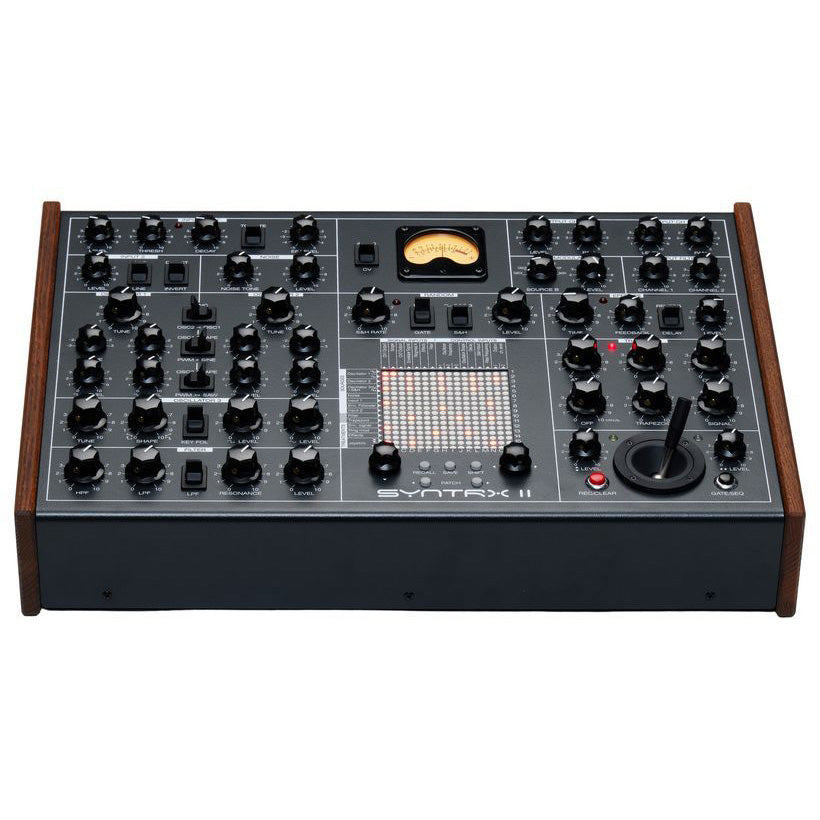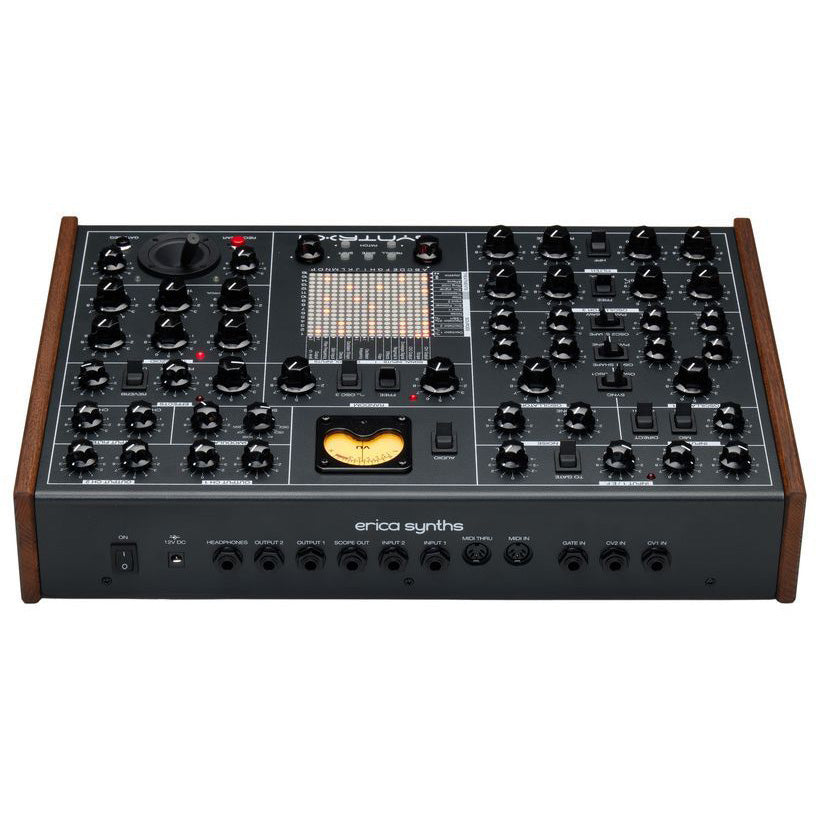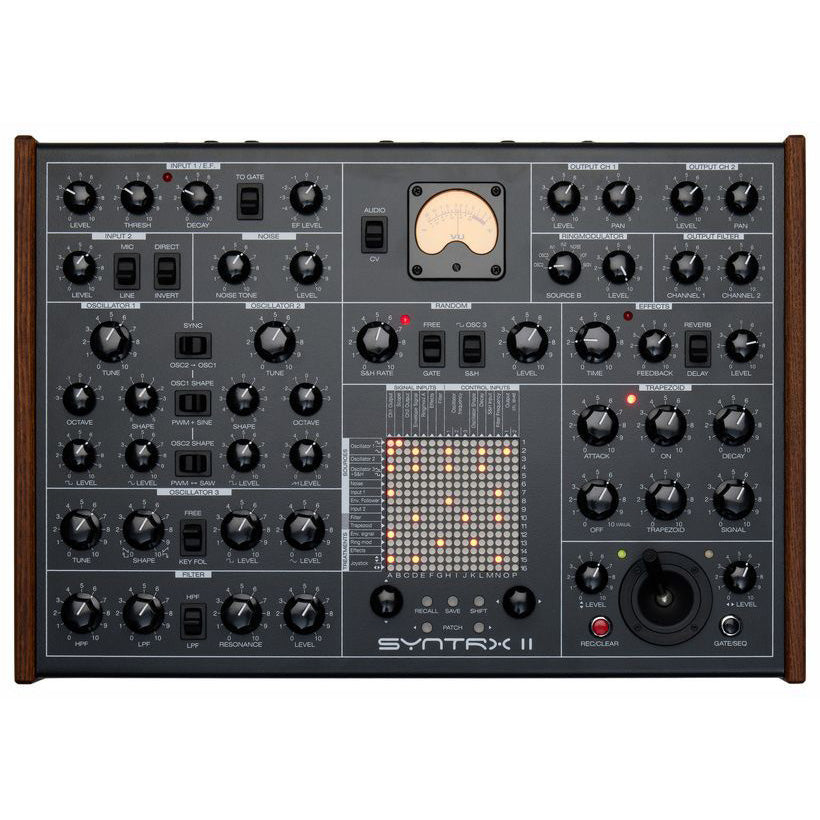- 2 oscillators with variable waveforms
- Hardsync
- FM oscillator
- Modulation oscillator with variable waveforms
- High pass / low pass filter
- FM filter
- Trapezoid generator
- Tunable noise
- Random sampling / sample and hold
- Ring modulator
- Delay / Reverb effect
- Audio input 1 with envelope follower
- Audio input 2 with switchable level
- Storable patch matrix
- 254 memory locations
- Joystick controller with recorder
- Output mixer with panning function
- Analogue VU meter
- Piano Roll Sequencer
- 2 CV inputs
- 1 Gate input
- MIDI input and pass-through
- Headphone output
Syntrx II from Erica Synths is an improved version of
thesame company
's Syntrx predecessor and also a descendant in the best sense of the famous EMS Synthi AKS from the 1970s. Both sonically and functionally close to the original at the time, Syntrx II is nevertheless capable of much more. A closer look at the stored patch matrix reveals that pretty much everything can be modulated and you get maximum flexibility. You can expect typically analogue sounds here, but also many experimental sounds. As usual, the high-quality instrument is very structured and organised, and with its anthracite-coloured case and dark wood side panels, it looks really premium. A final vintage touch is the analogue VU meter, which can optionally display output level or control voltages.
analogue oscillators 1 and 2 are stable in tuning and largely similar in design. They cover a wide range of over seven octaves and differ in their choice of waveforms and or oscillator 1 can also be animated with PWM. Oscillator 3 is less elaborate than the others, but can also be used as an LFO. All three oscillators, however, are equipped with variable waveforms. The filter combines the features of Highpass and Lowpass and comes surprisingly close to the sound of the old AKS synthesiser. The noise generator can be influenced in the character of the sound, which is an advantage, among other things, when noise is not only applied to rough basses, but also used for analogue percussion. Two different audio inputs allow external audio signals to be fed into all sound shaping processes. Whether triggering the trapezoidal generator with a drum machine, ring modulating your own voice or filtering samples, this synthesiser offers a wide range of possibilities for the creative use of external audio signals. At the centre of this analogue synthesiser we find a practical patch matrix, an analogue VU meter with two different display options, and a random voltage generator that takes its samples from either oscillator 3 or a noise generator. On the right side of the control panel we find - quite typical of the EMS Synthi series - a trapezoidal generator, which acts as an envelope. There is also the iconic joystick, which shines with an additional recording function. The ring modulator and delay can be installed anywhere in the signal path and sound excellent.
Theend of the signal path is formed by a two-channel mixer that can split each of the two channels in the pan.
is an extensive topic in Syntrx II. First of all, almost every connection has to be implemented through a patch matrix. This also applies to standards such as VCA with envelope modulation. The intensity is set in three steps in the patch matrix and via the level controls of all sources. In this way, many classic analogue sounds with 1-3 oscillators, powerful bass lines, complex FM sounds, and especially those sounds that we would place in the experimental realm: noisy tremolo sounds that end in a dense reverb path, Dalek-SciFi sounds, meandering sounds that push and slow each other down as the various components interlock, drone clusters full of their own life....
You can't do Syntrx II justice by limiting its modulation sources to oscillator 3, random and trapezoidal generator, as almost every section of this synth is capable of generating an event. The distinguishing feature here can also be the joystick, whose movements can be recorded and can affect almost every parameter. All of this predestines the Syntrx II for experimental musicians who appreciate or fancy the haptics of the EMS synthesiser.
Even the two audio inputs can be quickly and easily integrated into the sound shaping, so that the input guitar and drum machine are ring-modulated with each other, while one of the two signals opens the VCA, and the whole work is decorated with a delay effect
patch matrix is the heart of the Syntrx II, unlike its predecessor Synthi AKS, there is no longer a mechanical PIN matrix. The 254 memory locations can store all connections between the 16 sources and targets - by the way, ONLY the connections are stored, not the parameter settings. Here, you can define whether the oscillator is to be routed directly to the mixer and/or simultaneously be the FM source for the filter and be routed to the ring modulator. Or whether oscillator 3 modulates PWM from the other two oscillators. Additionally, you can temporarily overwrite memory locations and the next time you call it up you have the previous state again.
- Manufacturer:Erica Synths
- Construction / Number of Keys:Desktop without keyboard
- Sound Generation:Analog
- Polyphony:1
- Number of Sounds:254
- Integrated Effects Processor:Yes
- Number of Knobs:48
- Number of Keys:7
- Mounting Options:MIDI Step Sequencer
- MIDI Interface:Yes
- LINE IN:Yes
- LINE OUT:Yes
- Microphone Input:Yes
- Headphone Connection:Yes
- Power Supply:Adapter, external
- incl. Power Adapter:Yes
- Width (cm):45.7
- Height (cm):11.5
- Depth (cm):30.9
- Weight (kg):4









